Many farmers have been affected by the recent “lockdown” placed on the movement and sale of cattle due to Foot-and-Mouth disease (FMD). Towards the end of July the Department of Agriculture reported 116 open outbreaks in the country where Kwa-Zulu Natal, North West, Mpumalanga, Free State and Limpopo provinces accounted for the majority of the cases.
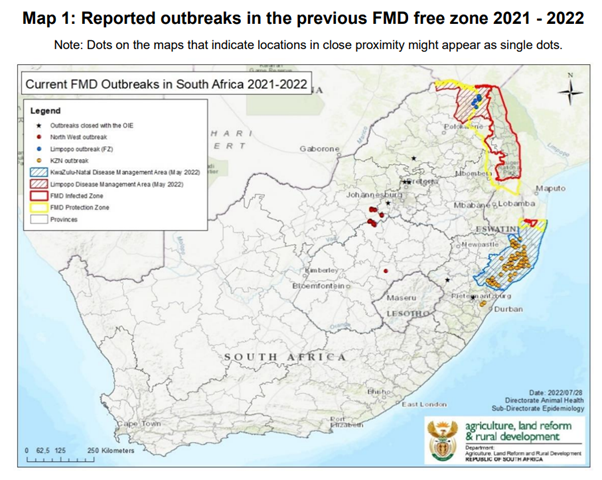
So, what is Foot-and-Mouth disease? FMD is a highly contagious viral vesicular disease of cloven-hooved animals. The virus can infect all wild and domestic cloven-hooved animals (of the domestic livestock species, cattle, buffalo, pigs, sheep, goats, and deer are susceptible to FMD, with the disease being most severe in cattle and pigs). Cattle are regarded as indicator hosts because of their susceptibility to infection, whilst sheep and goats are considered silent/maintenance hosts because the infections can spread through flocks showing limited clinical disease. FMD is excreted in high quantities in expired air, and in all secretions and excretions (including saliva, milk and semen) as well as from ruptured vesicles.
Modes of Transmission
- Direct contact between infected and susceptible animals – the main route of infection is via the oronasal route; the virus can also enter through breaks in the skin or mucosae. Stocking density is a determinant in the rate of spread of disease within an infected premises, with higher stocking densities seeing faster rate of spread. Movement of animals enables rapid dissemination of the virus over wide geographical areas
- Mechanical spread by people, rodents, insects, birds
- Contact with the carcasses of infected animals
- Contact with secretions
- Semen and embryos containing the virus
- Fomites – indirect contact by means of contaminated animal feed, straw, water, vehicles
- Airborne spread – cattle and sheep are most susceptible to infection by inhalation of contaminated aerosols and extremely small doses of the virus can initiate an infection.
Healthy people can harbour FMD sub clinically in the nasal passages and throat for up to 28-hours, which means that during FMD outbreaks responders should avoid moving between premises for a directed amount of time to avoid the possibility of transmitting FMD to susceptible uninfected animals. The incubation period of the disease for clinical signs is 1 to 14 days, but most commonly 2 to 5 days. The incubation period is largely dependent on strain, exposure, route of entry and the species infected. Excretion of FMD can begin 4 days before clinical signs become apparent and decreases about 4 to 6 days after the appearance of vesicles and when circulation antibodies appear. Excretion of the virus from foot lesions tends to last a day or two longer than from mouth lesions, so foot lesions might be a better source of the virus for diagnostic purposes. FMD has been detected in the milk and semen of experimentally infected cattle for 23 and 56 days post infection respectively.
Diagnosis and Pathology
The classical signs and lesions of FMD are described below. Note that a wide range of clinical syndromes can occur, ranging from inapparent disease with minimal lesions to severe clinical disease. The mortality due to FMD virus infections is low in adults (<5%) but much higher in younger animals. The course of FMD in cattle may last for 2-3 weeks or longer if there are serious secondary bacterial infections. Long term secondary effects may include hoof deformities and permanent damage to the udder. Clinical signs of FMD cattle include:
- Pyrexia accompanied by severe depression, inappetence and (in milking animals) a sudden drop or cessation of milk production
- Followed (within 1-2 days) by the appearance of vesicles, the predilection sites for which are the tongue, lips, gums, dental pad, interdigital skin of the feet and coronary bands, bulbs of the heels and teats. Not that vesicles can burst readily within 24 hours, so it is more common to see ulcers
- In the mouth, vesicles and ulcers are particularly prominent on the tongue, dental pad and cheeks. In severe cases, most of the dorsal surface of the tongue may slough. In uncomplicated cases, mouth lesions heal fairly rapidly over a 7–10-day period and eating may resume within a few days of rupture of vesicles
- Painful stomatitis (associated with unruptured and freshly ruptured vesicles), which causes excess salivation, lip smacking and cessation of eating, leading to rapid loss of body condition
- Foot lesions, which are accompanied by acute lameness reluctance to move
- Teat lesions which may lead to secondary mastitis
- Abortion
- Infection of very young calves may cause sudden death due to cardiac involvement without vesicular lesions (mortality can be as high as 50%)
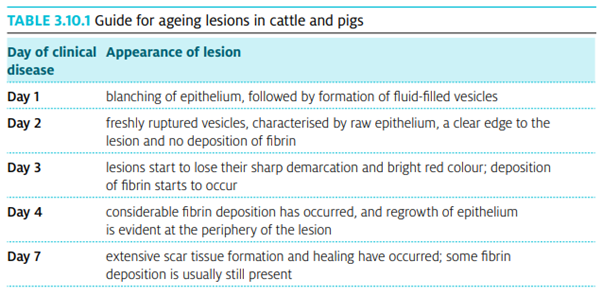
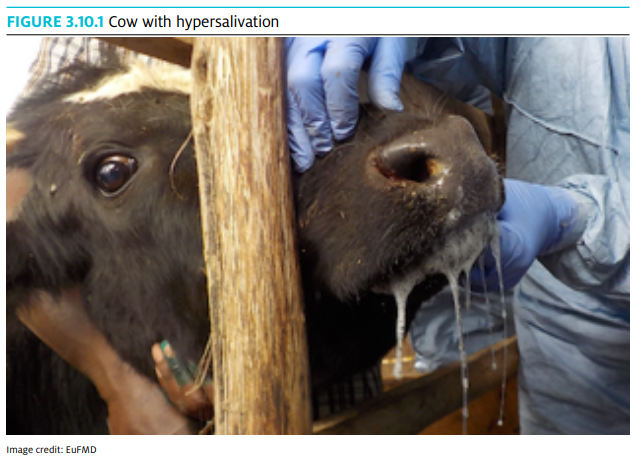

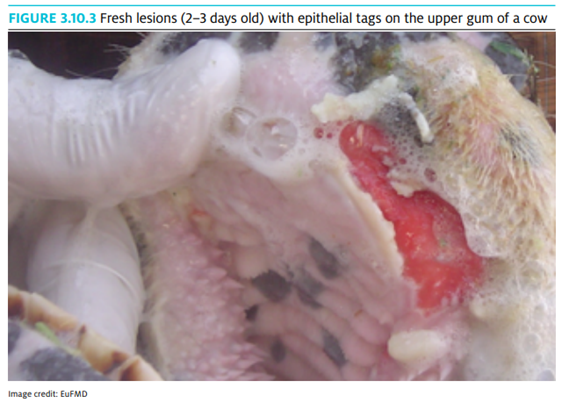

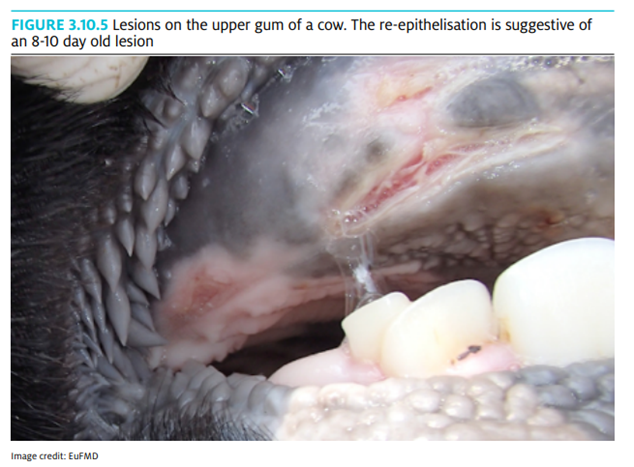
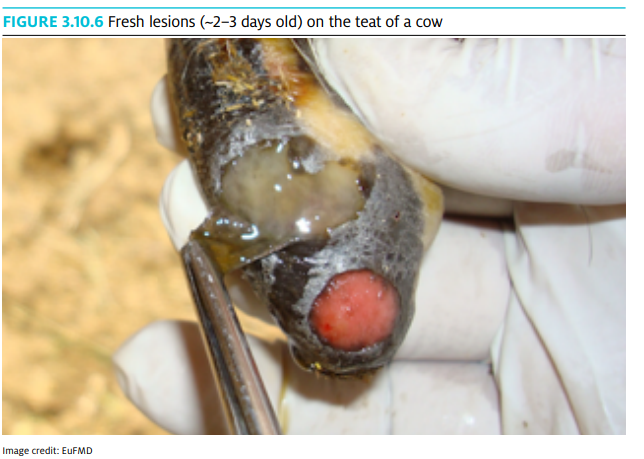
Containing the infection is of primary concern:
- Secure potentially infected animals in well fenced camps or pens, and prevent contact with unaffected herds
- Confine animals as well as potentially infected products and fomites to the property
- Move livestock away from farm borders, particularly in the case of suspected diseases for which the causal organism can be airborne over considerable distances
- Avoid actions that would encourage the dispersal of feral animals from the property
- Discourage unnecessary visitors from entering the property
Implementing Biosecurity Procedures
Entry and Exit Procedures in Low-Risk Biosecurity sites
- Wearing clean overalls and boots
- Wearing gloves when handling animals/carcasses
- Cleaning instruments in soapy water
- Limit access that contractors/visitors have to your livestock or livestock holding areas
- Have facilities and equipment in place for washing/disinfecting shoes, clothing and vehicles
- When new livestock arrive on your property, isolate them, and monitor them for signs of sickness for up to two weeks (minimum 7 days)

